Most Famous Caravaggio Paintings
Michelangelo Merisi da Caravaggio (1571 - 1610), widely known simply as Caravaggio, is one of the foremost figures of Baroque painting. His artwork stands out for exceptionally realistic style and dramatic use of light and shade (tenebrism). Both admired and criticized for his revolutionary techniques and radical break with ‘artificial’ Mannerism, the Italian painter was also known for his highly controversial lifestyle. In 1606, he was sentenced for murder for possibly unintentionally killing a young man leading to his exile from Rome. He died on his way back to Rome in 1610 in unclear circumstances.
Medusa
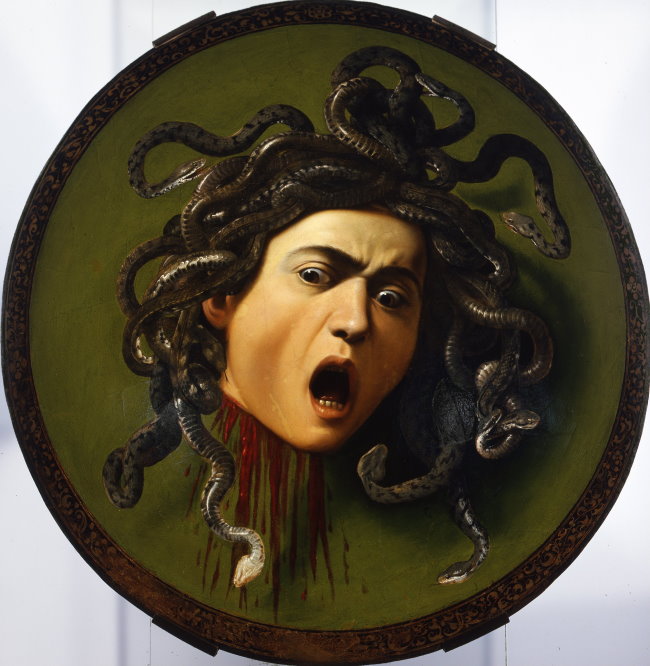
Completed around 1598, Caravaggio’s Medusa was commissioned by Cardinal Francesco Maria del Monte who later donated it to Ferdinand I de Medici. The oil painting, which is mounted on a convex wooden shield, depicts the severed head of the Greek mythological monster who turned anyone who gazed at her to stone. Caravaggio captured the exact moment of her beheading by Perseus helping himself with a shield that was given to him by goddess Athena. Like many other artworks from de’ Medici collection, Caravaggio’s Medusa can today be admired in the Uffizi Gallery in Florence, Italy.
The Calling of St Matthew

Caravaggio’s Calling of St Matthew is one of the most famous paintings of Jesus Christ inspiring Matthew, the tax gatherer, to become his follower. According to the biblical narrative, Jesus saw Matthew and said to him “Follow me” and the former rose and became his disciple. The panting was commissioned for the Contarelli Chapel in the San Luigi Dei Francesi in Rome, Italy and was completed around 1599-1600. Caravaggio was also commissioned to paint two more paintings for the Contarelli Chapel - The Martyrdom of St Mathew (1599-1600) and The Inspiration of St Matthew (1603). But the latter is the second version as the original Inspiration (1602) was rejected by the church authorities.
Judith Beheading Holofernes
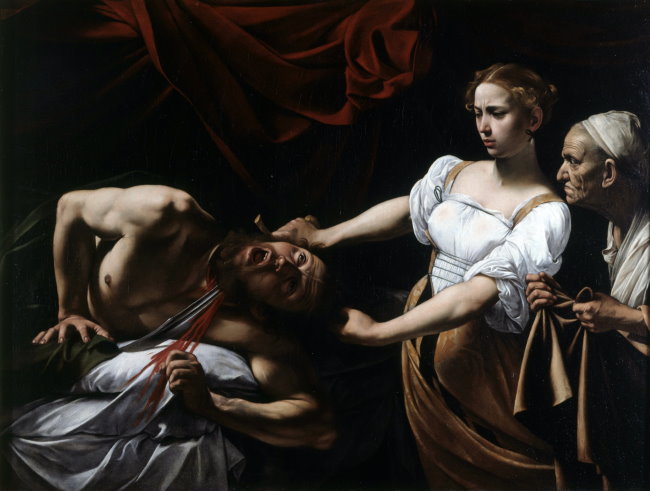
In his painting Judith Beheading Holofernes, completed around 1598, Caravaggio depicts the biblical scene of widow Judith beheading the enemy Assyrian general. To save her people, Judith seduces Holofernes only to be able to kill him. In 2014, a second version of the painting was found under an old mattress in an attic in Toulouse. In 2019, after Louvre turned down the offer to purchase it for €100 million, it was sold to an art collector for an undisclosed sum. However, scholars disagree whether the 2014-discovered version is indeed a lost Caravaggio or perhaps a copy by the Flemish painter Louis Finson (c.1574⁄80-1617). The undisputed Caravaggio’s Judith Beheading Holofernes is today housed in the National Gallery of Ancient Art in Rome, Italy.
Narcissus

Narcissus, commissioned from Caravaggio by an unknown Roman patron around 1600, shows the handsome youth admiring his own reflection in the water. Several versions of the myth of Narcissus exist but the best known is probably that from Metamorphoses by the Roman poet Ovid. According to the latter, the youth fell so deeply in love with his own reflection that he eventually pined away from his unrequited love. First attributed to Caravaggio only in 1916, Narcissus is today in the collection of the National Gallery of Ancient Art in Rome, Italy.
The Taking of Christ

The Taking of Christ shows Jesus being taken by Roman soldiers just after being kissed by Judas to identify him. Besides Jesus, Judas and three Roman soldiers, the scene also includes St John and a man with a lantern who is commonly accepted to be Caravaggio’s self-portrait. On indefinite loan to the National Gallery of Ireland from the Jesuit Community, the ‘Dublin’ Taking of Christ was rediscovered only in 1993. It was initially thought to be another copy of the lost masterpiece but is now widely accepted to be the original that was commissioned by the Roman nobleman and art collector Ciriaco Mattei in 1602.
Basket of Fruit
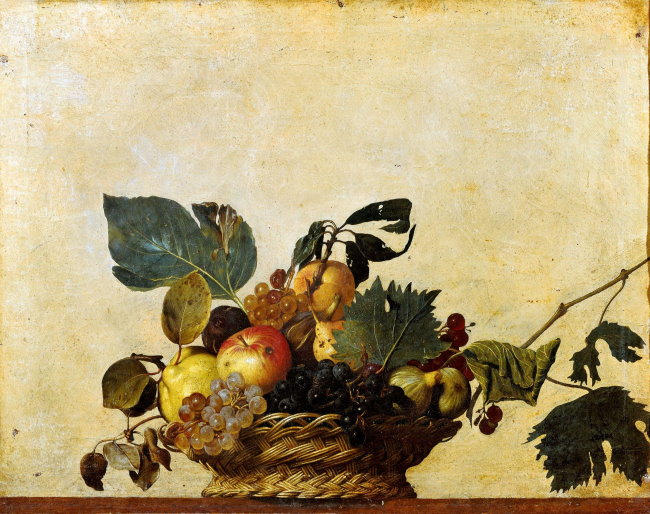
Caravaggio’s Basket of Fruit is widely regarded as the first modern still life painting. The wicker basket and fruit are the main subject of the painting which lacks other narrative. The basket of everything but perfect fruit showing obvious signs of decay bears a striking resemblance to the basket of fruit in the Supper at Emmaus. Although the fruit content is slightly different, the wicker baskets seem to be identical and in both paintings, the basket is placed dangerously at the edge of a table. According to most scholars, Caravaggio painted his Basket of Fruit between 1595 and 1600 over the work of another painter. The masterpiece is today on display in the Ambrosian Library in Milan, Italy.
Supper at Emmaus
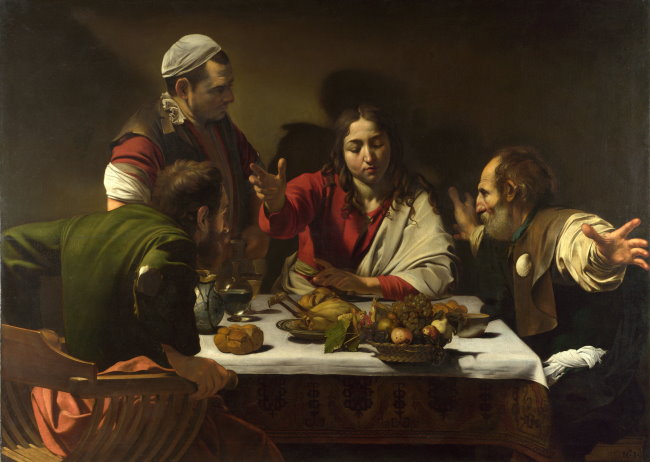
The Supper at Emmaus, painted by Caravaggio in 1601 for Ciriaco Mattei, depicts the moment the resurrected Jesus is blessing the bread and revealing his identity to his disciples Cleopas on the left and presumably Luke on the right in the town of Emmaus. While following the biblical account of the event, Caravaggio decided to add an innkeeper standing left to Jesus and a basket of imperfect fruit that is out of season. Furthermore, Jesus is painted beardless which was not in line with the tradition. However, in his 1606 version of the Supper at Emmaus (today in collection of the Pinacoteca di Brera in Milan, Italy), Caravaggio painted Jesus with a beard. The 1601 version is housed in the National Gallery in London, UK.
Saint Jerome Writing

As the painting’s title suggests, Caravaggio’s Saint Jerome Writing, also known simply as Saint Jerome depicts the Saint writing or according to some sources, translating the Bible. Executed for Cardinal Scipione Borghese around 1605-06, the painting is the earlier of two versions of the writing Saint. The second Saint Jerome Writing was painted in 1607 or 1608 - shortly after Caravaggio’s arrival to Malta - in the Oratory of St John’s Cathedral in Valetta. The earlier version, which is today housed in the Borghese Gallery in Rome, Italy, was for a long time attributed to the Spanish artist Jusepe de Ribera (1591-1652).
David with the Head of Goliath

David with the Head of Goliath is another Caravaggio masterpiece in the collection of the Borghese Gallery in Rome. According to most scholars, the artist painted one of his most famous paintings for Cardinal Scipione Borghese who is known to have it in his collection in 1650. But while some scholars date the painting to 1605, others are rather placing it to 1609-10. If, as suggested by some sources, the artist depicted the younger himself as David, the painting is a double self-portrait as most sources agree Caravaggio portrayed himself as Goliath. However, the model for Caravaggio’s David remains a matter of debate.
Conversion on the Way to Damascus

Created in 1601 for the Tiberio Cerasi’s funerary chapel in the Basilica of Santa Maria del Popolo in Rome, Italy, Caravaggio’s Conversion on the Way to Damascus depicts the conversion experience of Saint Paul the Apostle. According to biblical account, Paul intensely persecuted Jesus’ followers. But on his way from Jerusalem to Damascus, he experienced a divine revelation transforming him from a persecutor to an apostle who played one of the central roles in the spread of Christianity. Caravaggio painted Conversion on the Way to Damascus after the first Conversion of Saint Paul (today in the Odescalchi Balbi Collection in Rome) was rejected.
Crucifixion of Saint Peter

The Crucifixion of Saint Peter is another Caravaggio painting created in 1601 for the Tiberio Cerasi’s chapel in the Basilica of Santa Maria del Popolo in Rome. And just like the Conversion on the Way to Damascus, the Crucifixion of Saint Peter is also the second version. According to Giovanni Baglione’s biography about Caravaggio, the first versions of both paintings for Cerasi were rejected. As its title reveals, the Crucifixion of Saint Peter depicts the martyrdom of Saint Peter who - after being condemned to death - insisted to be crucified upside down because he felt he wasn’t worthy to be killed in the same way as Jesus.
Bacchus

Bacchus, dated to circa 1598, is a half-length portrait depicting the Greek god of wine Bacchus or Dionysus. There is no consensus about who was Caravaggio’s model. Among the most commonly suggested names is Mario Minniti, Italian painter who also appeared as a model in many other Caravaggio paintings. However, some scholars also suggest that Bacchus is actually Caravaggio’s self-portrait and that the artist helped himself with a mirror when using himself as a model. Today in the collection of the Uffizi Gallery in Florence, Bacchus was painted for Cardinal Francesco Maria del Monte. But in 1608, del Monte donated it (along Medusa) to Ferdinand I de Medici.
The Entombment of Christ
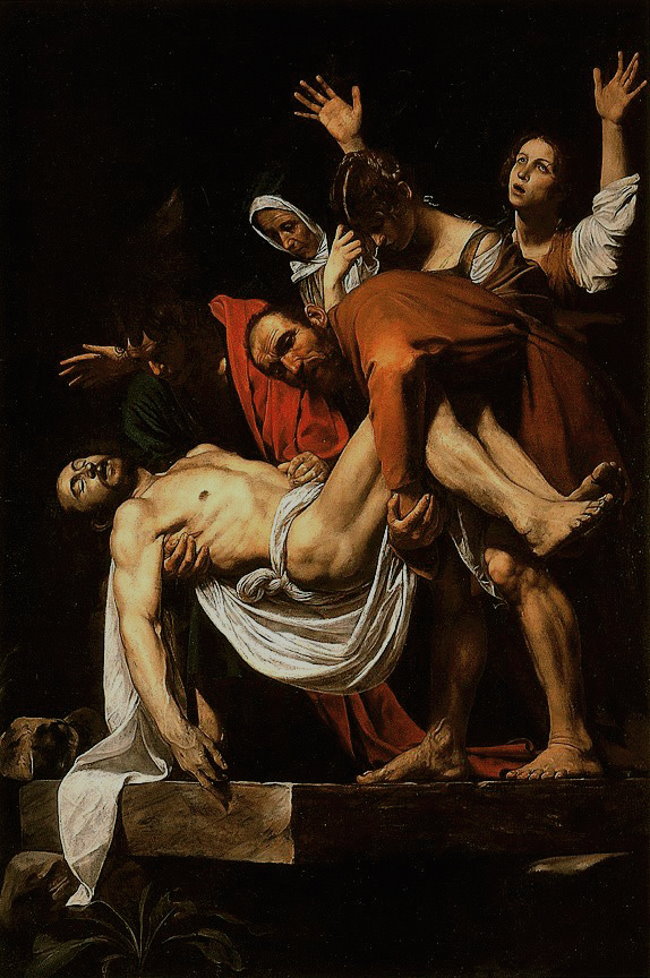
Caravaggio completed the Entombment of Christ, widely considered as one of his finest works, in 1604. The masterpiece is believed to be commissioned by Girolamo Vittrice for his family chapel in the Church of Santa Maria in Vallicella or Chiesa Nuova in Rome, Italy. The original, however, is today in the Vatican Pinacoteca, while Chiesa Nuova is home to a copy. Contrary to it’s title, the painting doesn’t depict Jesus’ burial as such but his body is rather being laid by John the Evangelist and Nicodemus on the so-called Anointing Stone used to close the sepulchre. Behind them are standing Mary Magdalene, Virgin Mary and Mary of Cleophas raising her arms to heaven.
Boy With a Basket of Fruit
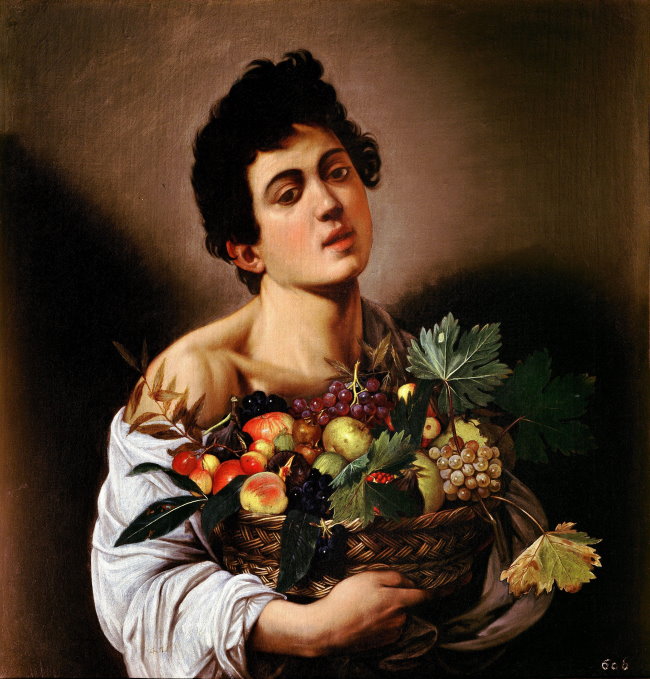
The Boy with a Basket of Fruit is dated to Caravaggio’s early period ca. 1593-95 shortly after he moved to Rome from his native Milan. The model for the youth holding a basket of fruit which - just like in the Basket of Fruit - also includes all its imperfections is thought to be Mario Minnitti who arrived in Rome about the same time as Caravaggio. The painting was probably created in the workshop of Guiseppe Cesari, Cavalliere d’Arpino from whom it was seized by Cardinal Scipione Borghese in 1607. It is today housed in the Galleria Borghese in Rome.
The Lute Player
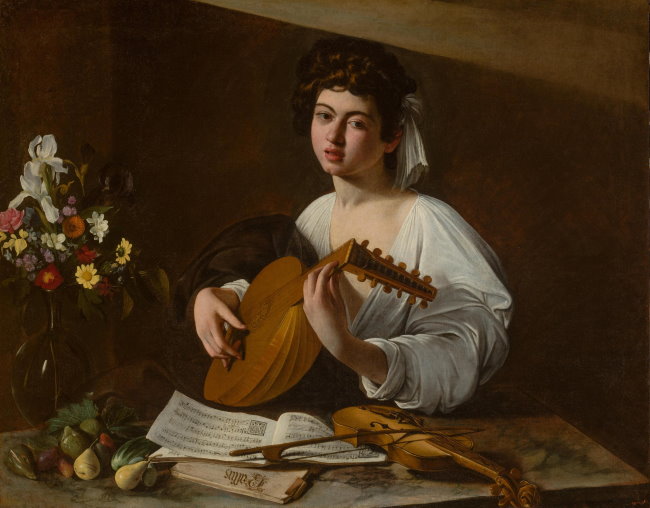
The Lute Player is another half-length portrait from Caravaggio’s early period which is thought to be modelled by Mario Minnitti. Today in the collection of the Hermitage Museum in St Petersburg, Russia, the masterpiece was painted for Marchese Vincenzo Guistiniani around 1595. The artist, however, painted another version for Cardinal Francesco Del Monte, which is today owned by the Wildenstein family. In 2001, a third version from the Badminton House in Gloucestershire, England, appeared at Sotheby’s auction in New York. But it wasn’t auctioned as a Caravaggio and was attributed to him only in 2006 although some scholars remain sceptical about Caravaggio’s authorship of the ex-Badminton version.
The Beheading of Saint John the Baptist
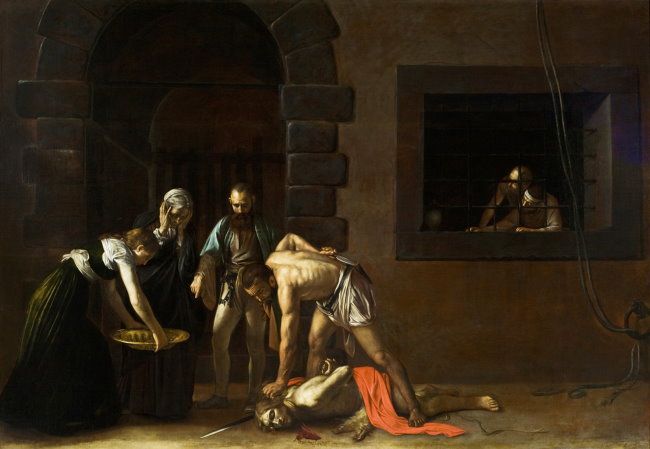
The Beheading of Saint John the Baptist is considered to be one of Caravaggio’s greatest masterpieces. Painted in 1608 for the oratory of the St. John’s Co-Cathedral in Valletta, Malta, the painting depicts the moment the executioner is about to finish the beheading of Saint John the Baptist. The blood oozing from Saint John’s neck forms ‘F. Michelangelo’ making it the only painting to include Caravaggio’s signature. The meaning of the signature spelled out in blood continues to be a matter of debate but according to most sources, Caravaggio was probably indicating he was a member of the Knights of Malta with the ‘F’ standing for ‘Fra’ or ‘knight’.
The Death of the Virgin
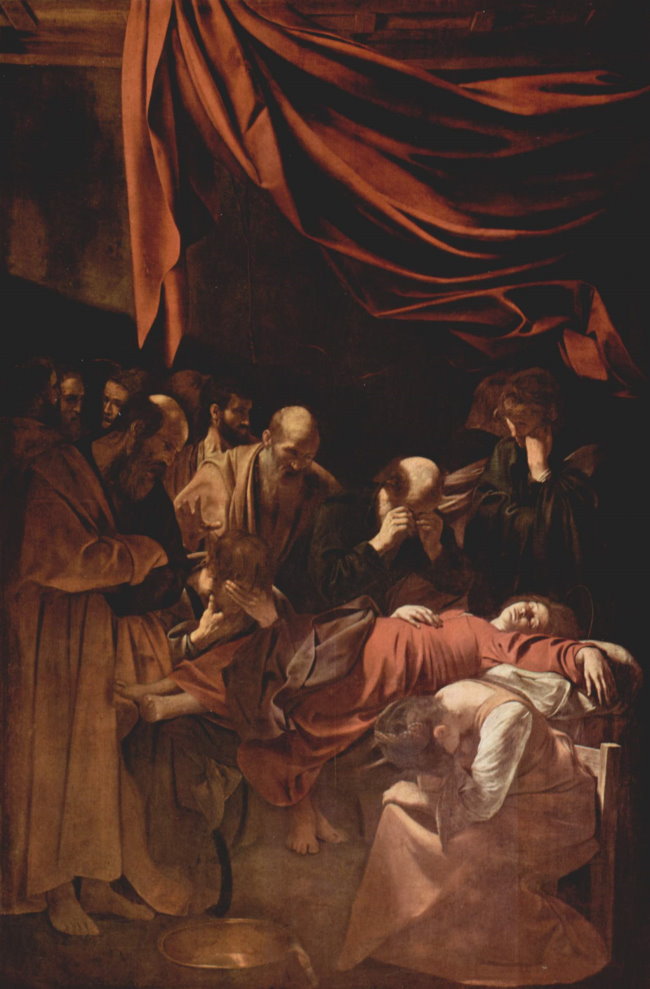
Caravaggio’s Death of the Virgin - as its title indicates - depicts the death of the Virgin Mary who is surrounded by the grieving apostles and Mary Magdalene. The painting, which was commissioned in 1601 for the Church of Santa Maria della Scala in Rome, Italy, was completed around 1605-1606. Although today regarded as one of Caravaggio’s finest works, it was rejected as unworthy for the church; according to most sources, probably because of the unorthodox and too realistic depiction of the deceased Virgin. In 1607, the painting was bought by the Duke of Mantua from whose collection it was acquired by Charles I of England and later Louis XIV of France. Today, it is on display in the Louvre in Paris, France.
The Musicians

Housed in the Metropolitan Museum of Art in New York, NY, since 1952, the painting titled The Musicians was painted for Cardinal Francesco Maria Del Monte around 1597. Caravaggio painted youths performing a concert; three are playing instruments or singing, while the fourth who is dressed as Cupid is reaching towards grapes. The central figure holding a lute is thought to be Mario Minnitti who has also been identified as the model in The Lute Player, Boy with the Basket of Fruit and Bacchus, among others. The second individual from the right is believed to be Caravaggio’s self-portrait, while the boy dressed as Cupid bears a great resemblance to the model in the Boy Peeling Fruit and Ecstasy of Saint Francis.
Young Sick Bacchus

The Young Sick Bacchus is an early Caravaggio’s self-portrait commonly dated to about 1593 or the time of the artists beginnings in Rome. According to scholars, the painting indicates Caravaggio’s illness - most likely malaria which explains the jaundiced or yellowish appearance of his skin and eyes. The painting, which has been suggested to be painted with the aid of a mirror, was in the collection of the artist’s early employer Guiseppe Cesari d’Arpino until 1607 when it was seized by Cardinal Scipione Borghese. It has been in the collection of the Borghese family ever since and is today on display in the Borghese Gallery in Rome.
Boy Bitten by a Lizard
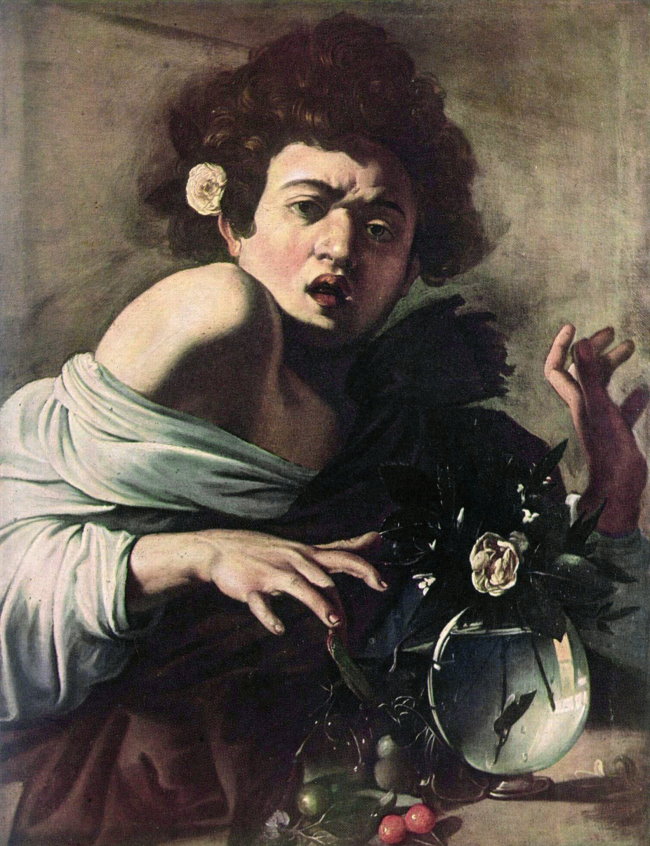
Painted in the mid-1590s, the Boy Bitten by a Lizard exists in two versions. One is today in the collection of the National Gallery in London, while the second is owned by the Roberto Longhi Foundation in Florence, Italy. Both versions, which are widely considered to be Caravaggio’s authentic works, portray a youth who moves back in pain after being bitten by a lizard hiding among the fruit. There is no conclusive explanation of the scene’s meaning; it could be implying to the pain that is caused by love, symbolizing the transience of life (vanitas) or as suggested by some scholars, be a study of extreme expression. The model in the painting remains equally inconclusive but some scholars suggested the Boy Bitten by a Lizard is actually Caravaggio’s self-portrait.
Published on Fri, Aug 28, 2020.